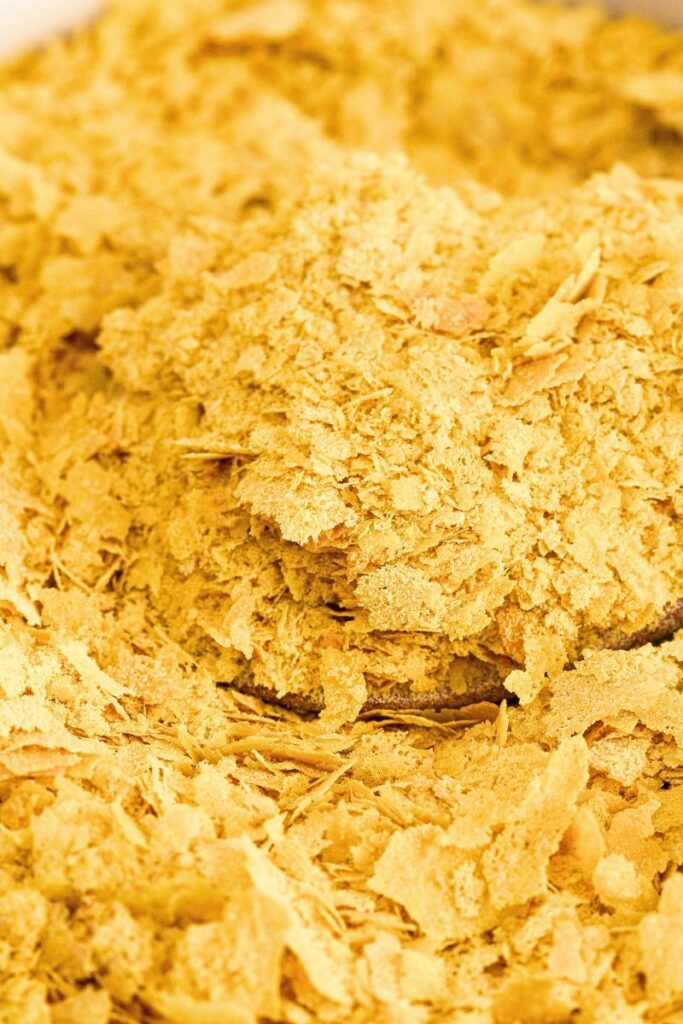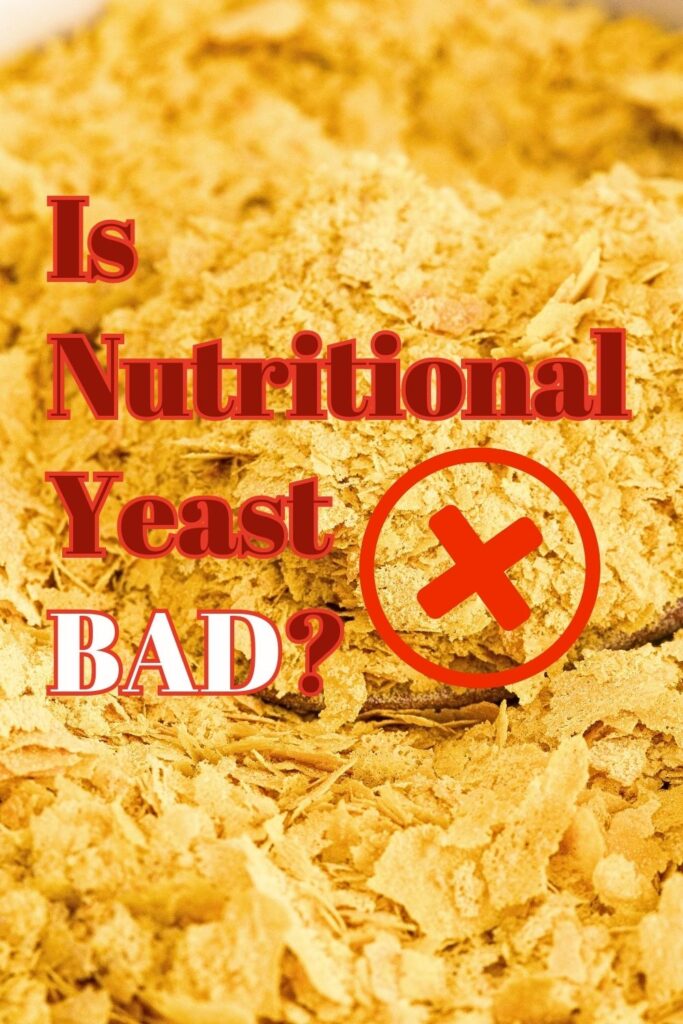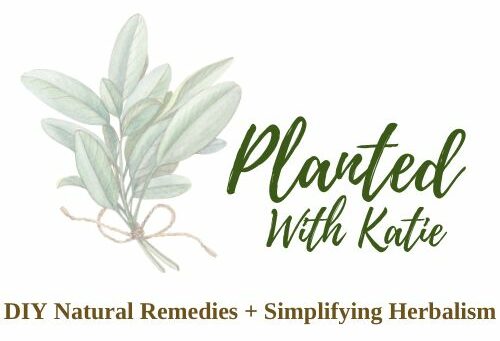Is Nutritional Yeast Bad? The Real Truth
There have been a lot of things said about nutritional yeast. Some call it the fountain of health, some say it’ll destroy your health. So what’s the real truth? Is nutritional yeast bad? Let’s uncover exactly that.

This post may include affiliate links. Please refer to our disclaimer for full disclaimer.
What Is Nutritional Yeast?
Nutritional yeast is a deactivated strain of Saccharomyces cerevisiae, a single-celled fungus commonly used in baking and brewing. It is grown on a mixture of sugar cane and beet molasses, which provides the yeast with the nutrients it needs to thrive. After the yeast is harvested, it is deactivated through a heating and drying process, which renders it inactive but still nutrient-rich.

Nutrition Facts of Nutritional Yeast
Nutritional yeast is packed with essential nutrients. It is an excellent source of B vitamins, including thiamine, riboflavin, niacin, vitamin B6, and vitamin B12, which are important for energy production, metabolism, and the health of the nervous system.
Nutritional yeast is also a complete protein, providing all nine essential amino acids necessary for building and repairing tissues. 1/4 cup nutritional yeast provides around 8-9 grams of protein. Additionally, it contains minerals such as zinc, selenium, and magnesium.
The specific nutrient daily values provided by 1/4 cup of nutritional yeast can vary slightly depending on the brand and specific nutritional composition. However, as a general guideline, here are the approximate daily values of certain key nutrients commonly found in nutritional yeast:
- Vitamin B1 (Thiamine): Around 770% of the Daily Value (DV)
- Vitamin B2 (Riboflavin): Approximately 590% of the DV
- Vitamin B3 (Niacin): Roughly 280% of the DV
- Vitamin B6: Approximately 560% of the DV
- Vitamin B12: Around 40% to 50% of the DV (note that the form of B12 may vary, and it is advisable to check the specific product's label)
- Folic Acid: Approximately 240% of the DV
- Zinc: Roughly 30% to 35% of the DV
- Selenium: Around 25% to 30% of the DV
- Magnesium: Approximately 20% of the DV
If you're looking for an easy way to add a delicious and nutritious ingredient to almost any meal or snack, try 1-2 tablespoons of nutritional yeast.
What Does Nutritional Yeast Taste Like?
Nutritional yeast has a savory, cheesy taste, and slightly nutty flavor. Many people compare its taste to that of Parmesan cheese, making it a popular ingredient in vegan and vegetarian dishes as a dairy-free cheese substitute.

What Is Nutritional Yeast Used For?
Nutritional yeast is a versatile ingredient used in various cooking applications, like vegan cooking. It can be sprinkled on popcorn, pasta, salads, and roasted vegetables for added flavor. It can also be used as a thickening agent in sauces and soups or incorporated into recipes for vegan cheese sauces, dips, and spreads.

Some people even enjoy nutritional yeast as a seasoning for homemade kale chips or tofu scrambles. I might go as far to say it is a staple in any vegan diet.
3 Myths About Nutritional Yeast
Despite its numerous health benefits, nutritional yeast has faced some misconceptions. Let's debunk three common myths associated with nutritional yeast.
Candida and Gut Health Issues
One myth surrounding nutritional yeast is that it contributes to candida overgrowth and gut health issues. Candida is a type of yeast that can cause infections in certain individuals, but it is important to note that nutritional yeast is different from the Candida species responsible for these infections. Nutritional yeast does not contain the same strains of yeast that can cause candida-related health problems. In fact, some research suggests that certain compounds found in nutritional yeast, such as beta-glucan, may have beneficial effects on gut health by promoting the growth of beneficial bacteria.
Neurotoxin
Another myth suggests that nutritional yeast contains a neurotoxin called glutamic acid or monosodium glutamate (MSG). Glutamic acid is an amino acid naturally present in many foods, including fruits, vegetables, and dairy products. While nutritional yeast does contain glutamic acid, it does not contain the concentrated levels found in MSG. Glutamic acid in nutritional yeast is a natural component of the yeast itself and is not added artificially like MSG.
Excessive Purine Content
Some individuals worry that the purine content in nutritional yeast may be harmful, especially for people with conditions such as gout. Purines are natural compounds found in various foods and are broken down into uric acid in the body. However, the purine content in nutritional yeast is relatively low, and moderate consumption is unlikely to cause any issues for most individuals, including those with gout. As with any food, individuals with specific medical conditions should consult with their healthcare provider for personalized dietary advice.

5 Benefits of Nutritional Yeast
Nutritional yeast offers numerous health benefits. Here are some of the key advantages associated with its consumption:
Nutrient-rich: As mentioned earlier, nutritional yeast is an excellent source of B vitamins, including vitamin B12, which is especially important for vegetarians and vegans who may have limited dietary sources of this vitamin.
Improved immune function: Nutritional yeast contains beta-glucan, a type of fiber that has been shown to enhance immune function and reduce the risk of certain infections.
Enhanced energy production: B vitamins play a crucial role in converting food into energy, so incorporating nutritional yeast into your diet can support optimal energy metabolism.
Promotes healthy skin, hair, and nails: The B vitamins in nutritional yeast contribute to healthy skin, hair, and nails by supporting cell regeneration and promoting the production of collagen and keratin.
Supports a healthy nervous system: The B vitamins found in nutritional yeast are essential for maintaining a healthy nervous system, as they are involved in the production of neurotransmitters and the proper functioning of nerve cells.
The Best Brand of Nutritional Yeast
When it comes to choosing a brand of nutritional yeast, there are several reputable options available. Amongst the vegan community, some popular brands include Bragg, Bob's Red Mill, and Red Star. I like Anthony's fortified nutritional yeast flakes. It's essential to choose a brand that is non-GMO, organic if possible, has positive customer reviews, and provides high-quality products.
You can find these products online through Amazon or any health food stores, like Whole Foods.
Should I Buy Fortified or Unfortified Nutritional Yeast?
Nutritional yeast is available in both fortified and unfortified forms. Fortified nutritional yeast is enriched with additional vitamins, particularly vitamin B12, which is important for individuals following a plant-based diet.
If you are concerned about your vitamin B12 intake since it is an essential vitamin, choosing a fortified nutritional yeast can be beneficial as it is a good source of B vitamins. However, if you already obtain sufficient amounts of B vitamins from other dietary sources or supplements, unfortified nutritional yeast can still provide the savory taste and nutritional benefits without the additional fortification.
Who Should Not Eat Nutritional Yeast?
While nutritional yeast is generally considered safe for consumption, there are a few groups of people who should approach it with caution or avoid it altogether.
Individuals with IBS or Crohn's disease: Some people with irritable bowel syndrome (IBS) or Crohn's disease may be sensitive to yeast products, including nutritional yeast. If you have these conditions, it's best to consult with a healthcare professional to determine if consuming nutritional yeast is suitable for you.
People with a sensitivity to yeast products: Individuals with a known sensitivity or allergy to yeast should avoid nutritional yeast to prevent any adverse reactions.
Migraine sufferers: Nutritional yeast may contain compounds like tyramine that can trigger headaches in some individuals. If you experience migraines, it's advisable to monitor your response to nutritional yeast and consult with a healthcare professional if necessary.
What About Gluten Intolerance?
The good news is nutritional yeast itself does not contain gluten, making it safe for individuals with gluten intolerance or celiac disease. However, studies have found that some individuals with these conditions may have antibodies to Saccharomyces cerevisiae, the yeast strain used to produce nutritional yeast. This suggests that nutritional yeast and other yeast-based products may or may not worsen symptoms of gluten intolerance or celiac disease in some individuals.
If you have gluten intolerance or celiac disease, it is recommended to be cautious when consuming nutritional yeast and observe how your body responds to it.
Nutritional Yeast Substitutes
If you prefer to avoid nutritional yeast or cannot consume it due to dietary restrictions or personal preferences, there are several alternatives available that can provide similar flavors or nutritional benefits. Some common substitutes for nutritional yeast include:

Vegan cheese alternatives: Many plant-based cheeses are made using nutritional yeast to mimic the cheesy flavor. Look for vegan cheeses labeled as "nutritional yeast-based" or "yeast-derived" for a similar taste.
Parmesan cheese: If you can tolerate dairy, grated Parmesan cheese can be used as a substitute for nutritional yeast in recipes that call for a cheesy flavor.
Herbs and spices: Depending on the recipe, you can experiment with using herbs and spices such as garlic powder, onion powder, smoked paprika, or turmeric to add flavor and depth.
Vegetable broth or stock: In some recipes, using vegetable broth or stock can provide a savory flavor similar to what nutritional yeast offers.
How To Know If Your Nutritional Yeast Has Gone Bad
Nutritional yeast, like many food products, can go bad or spoil over time. Here are a few signs to look for to determine if nutritional yeast has gone bad:
Expiration date: Check the expiration date on the packaging. If the nutritional yeast has passed its expiration date, it's a good indication that it may have gone bad.
Change in color or appearance: Fresh nutritional yeast typically has a light yellow or beige color. If you notice any discoloration, such as darkening or the development of mold, it's a sign that the yeast has spoiled and should be discarded.
Foul smell: Nutritional yeast should have a pleasant, savory aroma. If you detect any unusual or foul odor, it could be an indication of spoilage.
Bitter taste: Nutritional yeast has a naturally nutty and slightly cheesy flavor. If the taste becomes bitter or unpleasant, it may have gone bad.
Moisture or clumping: Nutritional yeast should be dry and powdery. If you notice any signs of moisture or clumping, it could be a sign that moisture has entered the packaging and caused the yeast to spoil.
Presence of pests: If you observe any signs of pests, such as insects or bugs, in the nutritional yeast, it should be discarded.
It's important to store nutritional yeast properly in an airtight container in a cool, dry place to help extend its shelf life. If you're unsure about the quality or safety of your nutritional yeast, it's best to err on the side of caution and discard it to avoid any potential foodborne illnesses.
So Is Nutritional Yeast Bad For You?
The bottom line is that nutritional yeast can be a very healthful food for most people if used in moderation. Like any food, consuming it in excess can potentially lead to health risks. It is not recommended to consume nutritional yeast by the spoonful each day. Instead, it is best to incorporate it into occasional recipes or sprinkle it onto food as a flavorful topping, similar to how you would use Parmesan cheese.
Nutritional yeast has numerous health properties that can improve one's quality of life, and it also adds a delicious taste to dishes. However, it's important to note that if you have a known adverse reaction or sensitivity to nutritional yeast, it is best to avoid it and explore alternative options.

Ultimately, you are the best judge of whether a food is 'good' or 'bad' for you. Pay attention to how your body responds to nutritional yeast and make informed decisions based on your individual needs and preferences.
In conclusion, nutritional yeast is a versatile and nutritious ingredient that can be a valuable addition to a balanced diet. It offers a wide range of health benefits, including being a rich source of B vitamins and supporting immune function.
While it may not be suitable for everyone, particularly those with specific sensitivities or medical conditions, most individuals can enjoy nutritional yeast in moderation without any adverse effects. So go ahead, experiment with nutritional yeast in your recipes, and savor its unique taste and nutritional goodness.
My Favorite Vegan Recipes With Nutritional Yeast
If you're looking to incorporate nutritional yeast into your cooking, here are a few favorite recipes that showcase its versatility and deliciousness:
Broccoli Cheddar: Make a creamy and cheesy broccoli cheddar soup using nutritional yeast as a dairy-free alternative to traditional cheese.
Tofu Scramble: Add nutritional yeast to your tofu scramble for a savory and "eggy" flavor. Try my Tofu Egg Bites recipe for a similar taste and texture!
Kale Chips: Toss kale leaves with olive oil, nutritional yeast, and seasonings, then bake them in the oven for a crispy and nutritious snack.
Cheese Sauce: Create a dairy-free cheese sauce by combining nutritional yeast, plant-based milk, and spices. Drizzle it over pasta, nachos, or roasted vegetables for a cheesy delight.


